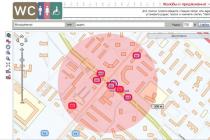Modern electrical equipment must receive electrical energy of certain parameters in a reliable and safe way.
The civilized development of society makes people more dependent on a variety of electrical and electronic devices, whose resistance to an accidental increase in voltage is not great.
Overvoltage in an electrical product (device)- voltage between two points of an electrical product (device), the value of which exceeds the highest operating voltage value. (GOST 18311-80).
Overvoltage may result from:
switching on and off high-power consumers, especially of a capacitive or inductive nature;
Atmospheric discharge directly into the power supply network of the object or near the object ( atmospheric overvoltage);
Penetration into the electrical wiring of an overvoltage wave from other equipment (for example, water pipes);
Electrostatic discharge between devices.
In the event of a direct lightning strike into the power supply network or indirectly through induction, in some wires inside the house, it can reach a level from several kV to several tens of kV, and the overvoltage resistance of modern electronic devices does not exceed 1.5 kV.
Existing technical standards oblige the use of lightning protection systems in construction. European standard 1EC 664A divides electrical wiring into four overvoltage categories: IV, III, II and I (Fig. 1).
Division of electrical wiring into overvoltage categories
Category IV - refers to devices located in the first part of the wiring: power lines of the main boards, for which the impulse resistance of the insulation must be at least 6 kV (due to the direct risk of atmospheric overvoltage or other types of overvoltage).
Category III - refers to devices and parts of the wiring (for example, connections) endangered: atmospheric overvoltages reduced by overvoltage arresters (type A) installed in the first part of the wiring; Protected energy consumers ETITEC D - overvoltage from switching on and off electrical devices high power.
Owners of valuable equipment (eg information equipment) should be aware of the risk of overvoltage and take precautions.
ETITEC varistor surge arresters are modular devices that protect electrical wiring from the effects of overvoltages, both atmospheric and arising from on-off.
The most important element of the limiter is in
aristor. A varistor is a pill-type rheostat made of zinc oxide (ZnO), a cermet alloy whose resistance is nonlinear and highly dependent on the voltage across its terminals. It has a very high resistance for a low (about 275 V) rated voltage and very low for a voltage of the order of several tens of kV.During normal work limit it varistor element is constantly under mains voltage. Due to the aforementioned high resistance for low voltage, the current passing through the varistor (called leakage current) is very small (less than 0.5 mA). The protective activity of this element consists in passing the discharge current to the ground after reaching a voltage at its terminals equal to the voltage of its ignition.
The time required for the limiter to operate from the moment the ignition voltage is applied is several tens of nanoseconds. The short response time of varistor arresters is an advantage over spark gaps. After triggering and passing the discharge current, the varistor arrester returns to the insulating state in a very short time, preventing the flow of subsequent current.
Varistor elements allow parallel connection in order to increase the load current capacity of complete arresters, which is also their serious advantage. Each arrester has a thermal fuse, which, in the event of an excess of the permissible current flowing during normal operation, disconnects the varistor, creating an open circuit in the electrical circuit in which it operates.
Classification of ETITEC surge arresters
According to VDE 0675, ETITEC varistor surge arresters are divided into the following groups, depending on the function and place of installation, as well as the required protection level:
A - limiter with a clamp for a line (cable) without insulation;
В - limiter with double clamp, insulation puncture on both sides - up to 95 mm2;
C - arrester with a linear clamp in the form of a wire with AsXSn insulation 16 mm2 - 200 mm long;
D - arrester with double clamp, insulation puncture on one side - up to 95 mm2;
E - stop without clamp, M8 threaded bolt.
Group A - ETITEC A. Arresters of this group are designed to protect low voltage devices and networks from overvoltage arising from the ingress of discharges into objects located near overhead power lines or directly into a line on great distance from the installation site of these limiters.
Limiters are mounted in accordance with the relevant standards outside the objects - on poles, especially in places where the overhead line passes into cable line and the impulse voltage should not exceed 6 kV. more than 10 mm2 (Cu) and 16 mm2 (AI), and these sections should be as short as possible.
Arresters mounted in lines are recommended to be placed at the grounding points of the PE wire or the ground-zero wire - PEN. In other cases, you need to make a ground electrode, to which you need to connect the PE or PEN wire, to which the grounding clamp of the arrester is connected. surge suppressors should not be higher than 10 ohms.
Group B - ETITEC B. Group B limiters are the first stage of protection inside the building. They are designed to limit overvoltages arising from:
discharge currents during a direct lightning strike into an object;
Nearby impact or direct impact into the object's power line - air or cable - low voltage;
Overvoltage induction.
Their main task is to limit overvoltages to the level of resistance
v isolation of receivers with a shock voltage of 4 kV, as well as discharge to the ground electrode of the electrical energy released during a direct lightning strike into the power supply network. When ETITEC B limiters are used, there is no need for any guard intervals -Varistor arresters, during the passage of a large current (extinguishing the shock wave), do not entail any electric arc surges, as is the case with spark gaps.Group C - ETITEC C. The main task of the group C arresters (second stage of protection) is to reduce the overvoltage passed through the group B arresters and the value of which is still high for the protected devices.
The limiters must be connected in distribution boards at the points of distribution of electrical wiring. They can also be connected at the junction or in the main switchboard (as the first stage of protection) of objects where 2-stage protection is not required, i.e. without an external lightning protection system and supplied via a cable line. The permissible level of overvoltage that can withstand the insulation of the receivers in the area of connection of the ETITEC C limiter should be no more than 2.5 kV.
This type of arrester is intended primarily for installations where a low current (about 0.3 mA) is required through the arrester at a nominal voltage Un - called leakage current.
Group D - ETITEC D. Group D arresters are designed for precise protection of consumers, which are especially sensitive to short overvoltages and whose insulation resistance does not exceed 1.5 kV. They are also necessary to protect devices in case the distance between the group C limiter and the receiver is too great (over 15 meters).
Arresters of group D must work together with arresters of groups B and C together in a multi-stage protective system and be adapted for mounting on a TN35 rail (DIN rail).
Varistor surge arresters
designed for long-term operation - no maintenance. Under nominal conditions, the duration of the limiters is determined at 200 thousand hours, and during this period they can be triggered an uncountable number of times.Elements for remote signaling of damage have been added to the limiters
varistor elementas a result of overvoltage when exceeding certain nominal values. The ability to remove the varistor stack from the arrester base is an advantage of these arresters over locked arresters.Nowadays, power supply systems and loads are becoming more complex, hence the likelihood of voltage surges increases. The main sources of peak voltages can be electric motors, capacitors and electrical converting equipment. Lightning strikes to overhead power lines can also cause extremely dangerous high energy transients. When measured in electrical systems oh, these transients are "invisible" and almost completely unavoidable risks. They occur regularly in low voltage circuits and can reach peak values of many thousands of volts. Therefore, the measuring equipment must be reliably protected against voltage transients.
The European standard IEC61010-1 establishes overvoltage categories based on the distance of the equipment from the power source (Table 1) and the natural attenuation of transients occurring in the power supply system. Higher categories are closer to the power source and require more protection from the metering equipment.
Voltage classifications are available within each equipment category. It is the combination of equipment category and voltage classification that determines the maximum transient immunity of the device.
The IEC61010 test procedures take into account three main test criteria: steady-state voltage, peak impulse transient voltage and source impedance. These three criteria taken together give true meaning voltage resistance of the device.
Within the category, a higher "operating voltage" is combined with a higher transient voltage. For example, a 600 V category III meter is tested with a 6000 V transient, while a 1000 V category III meter is tested with an 8000 V transient. Less obvious is the difference between the 6000 V transient for 600 V category III and 6000 V transient for Category II 1000 V. They are not the same thing. This is where source impedance comes into play. Ohm's Law (I = U / R) shows that a 2 Ohm test source for Category III has six times the current capacity of a 12 Ohm test source for Category II. A CAT III 600 V meter is known to have better transient protection than a CAT II 1000 V meter, although its so-called "voltage class" may be perceived to be lower (Table 2).
| Category IV | Three-phase on the power input, any overhead lines |
|
| Category III | Three-phase power supply, including single-phase lighting lines |
|
| Category II | Single-phase connected loads |
|
| Category I | Electronics |
|
Table 2. Values of transient voltages for voltage categories of electrical equipment
| Overvoltage equipment category | Working voltage | Peak impulse transient voltage (20 repetitions) | Test source (Om = V / A) |
| Category I | 600 V | 2500 V | |
| Category I | 1000 V | 4000 V | Source with an internal resistance of 30 ohms |
| Category II | 600 V | 4000 V | |
| Category II | 1000 V | 6000 V | 12 ohm source |
| Category III | 600 V | 6000 V | |
| Category III | 1000 V | 8000 V | Source with an internal impedance of 2 ohms |
| Category IV | 600 V | 8000 V | Source with an internal impedance of 2 ohms |
443.2.1 Purpose of classification
Note - See Table 44B.
The stress categories should characterize the varying degrees of suitability of the equipment in terms of its long-term operation and the permissible risk of failure. By choosing the level of equipment impulse insulation resistance (impulse overvoltage resistance) applied to the entire electrical installation, the probability of equipment failures can be reduced to a predetermined allowable value, providing a basis for managing impulse overvoltage.
The largest characteristic number of the impulse resistance category indicates a higher specific impulse impedance of the equipment and makes possible a wider choice of methods for controlling impulse overvoltage.
NOTE Overvoltages of atmospheric origin physically insignificantly weaken the processes occurring in most installations. Research has shown that the concept of a probabilistic approach is justified and useful.
443.2.2 Description of categories of impulse resistance equipment (categories of equipment of impulse voltage)
Impulse resistance equipment of category I is intended for connection to existing electrical installations of buildings. Protective equipment is located outside the equipment, or in an existing installation, or between a particular installation and equipment, to limit transient overvoltages to a specified level.
NOTE Examples of such equipment are household appliances, portable tools and the like.
NOTE Examples of such equipment are switchboards, circuit breakers, wiring systems (see IEC 60050 (826) [ 1 ], including cables, junction boxes, switches, sockets) in an existing installation, and equipment for industrial applications, as well as other equipment such as stationary motors pre-wired to a specific installation.
Impulse resistance equipment of category IV is intended for use near electrical installations of buildings in front of the main switchboard.
NOTE Examples of such equipment are electrical meters, primary overcurrent protection devices and overvoltage control devices.
443.3 Devices for overvoltage control
Notes (edit)
1 Direct lightning strikes into overhead lines of supply networks with voltage up to 1 kV or into electrical installations of buildings (external influence conditions AQ3) are not considered; see IEC 61024-1 [ 2 ].
NOTE 2 The management of the overvoltage caused by the switching action is not necessary in most cases, because the statistical evaluation has shown that the switching overvoltage higher than the category II overvoltage level is unlikely.
If the installation of surge protective devices is required in accordance with the instructions in this section, the conditions of the following section must also be observed.
O provide protection of low voltage systems against overvoltage.
general information
- this is a sudden increase in voltage (impulse or voltage wave superimposed on the rated mains voltage) to dangerous values for the electrical installation. It is characterized by the rise time (tf) in μs and the slew rate in kV / μs.
They are subdivided into external (atmospheric) and internal (switching).

External overvoltage occur during direct lightning strikes into an electrical installation or are induced (induced) in lines during lightning strikes near them.
Internal overvoltage occur during abrupt changes in the operating mode of the electrical installation (disconnection of unloaded lines, disconnection of the no-load current of transformers, phase closure in a network with an isolated neutral to ground, resonance, ferroresonance phenomena, etc.).
Danger of overvoltage:
- failure of sensitive electronic equipment,
- violation of the normal operation of equipment and related processes,
- Short circuit, fires in electrical installations, danger to human life, etc. in case of insulation breakdown.
Each electrical installation must have overvoltage protection.
Protection of objects and electrical equipment from the effects of lightning and overvoltage is produced outside and inside each object.
To devices outdoor protection includes lightning collectors, lightning rods, grounding systems, lightning arresters, etc. Internal protection measures include potential equalization, shielding, etc.
Elements internal protection are lightning current and overvoltage arresters. Overvoltage limitation by means of lightning current and overvoltage arresters is carried out as standard in three stages, and each stage should reduce the overvoltage.
According to the maximum permissible overvoltage, the LV lines are divided into 4 overvoltage and impulse withstand categories Uimp (1.2 / 50 μs) for separate parts object. For a network with a rated voltage of 230/400 V a.c .:
On the lines entering the building (to the main switchboard), the overvoltage should not exceed 6 kV, in distribution boards inside buildings 4 kV, for consumer equipment connected through sockets and other connectors 2.5 kV and for specially protected equipment (electronic, etc.) n.) 1.5 kV.
Arresters with protection degree 1 ... 3 are installed on the section of separate overvoltage categories.
The European standard IEC 61643-1 divides arresters into classes I, II, and III, which corresponds to our designation of 1, 2 and 3 classes.
Previously, the German norm E DIN VDE 0675-6 was used, which divided overvoltage protection for LV valves into 4 classes: A, B, C and D. Class A overvoltage protection devices are intended for external electrical installations. Overvoltage protection devices of classes B, C and D are designed in series for the boundaries of zones 0-1, 1-2 and 2-3.
Note: Several concepts are used in overvoltage protection. The most used concept is zone protection concept... In the zonal concept, the protection in the zones coincides with the division of buildings:
- the boundaries of the first zone are formed by the facade of the building,
- the second zone - the walls of the rooms,
- the third zone - separate inputs to the equipment.
For overvoltage protection devices used in low-voltage distribution networks, three test classes are defined according to IEC 61643-1:
- class I tests:
are carried out with a rated discharge current (In), a voltage impulse of 1.2 / 50 μs and a maximum impulse current Iimp;
- class II tests:
are carried out with a rated discharge current (In), a voltage pulse of 1.2 / 50 μs and a maximum discharge current Imax;
- class III tests:
are carried out with a combined wave (1.2 / 50 and 8/20 μs).
Devices subject to class I testing are usually recommended for objects in places of intense impact, for example, line entry into buildings with lightning protection systems.
Devices to be tested in Class II or III are exposed to shorter pulses.
Surge protection devices are classified into three classes:
-Type 1,
tested in class I: arresters capable of carrying currents (partial) in direct lightning strikes on the basis of their special design.
-Type 2,
tested in class II: arresters capable of absorbing overvoltages arising from near or distant lightning strikes, as well as from switching in the network.
-Type 3,
tested in class III: arresters serving to protect individual consumer devices or groups of devices against overvoltage, are installed near the outlets.
1st degree (preliminary protection, type 1) provide lightning current arresters, which delay most of the overvoltage wave, and are also capable of removing lightning currents or their essential parts without damage.
Lightning currents that occur in a direct lightning strike can be simulated using a 10/350 μs pulse waveform current.
The lightning test current reproduces both the rapid rise and the high internal energies of a real lightning. Lightning arrester type 1 (formerly class B) and external lightning protection modules are tested with this current.
In the worst case, with a 2-wire power supply, the lightning current arresters must discharge 50 kA / pole, with a 4-wire power drive 25 kA / pole with a 10/350 μs waveform.
Such parameters can only be achieved by devices designed on the basis of a spark gap.
2nd degree (medium protection, type 2) provide overvoltage arresters based on varistors (nonlinear resistance, dependent on voltage - resistance decreases with increasing voltage).
Surges from remote lightning strikes and switching operations are reproduced with an 8/20 μs test pulse. The internal energy of this impulse is significantly less than the test current of the lightning wave of the impulse current 10 / 350μs. Surge arresters type 2 (formerly class C) are loaded with this test impulse. They must be capable of dissipating atmospheric overvoltages or overvoltages caused by switching processes in a network with a waveform of 8/20 μs without damage.
In the vast majority of cases, type 2 surge arresters are installed behind type 1 lightning current arresters, which reduce overvoltage and limit the energy of the overvoltage wave. In this case, a conductor length> 15 m must be observed or isolating inductors must be installed. In fig. 2 shows a comparison of the energy dissipated by a 50 kA lightning current arrester and a 15 kA overvoltage arrester.
Waveform and energy of 8/20 μs and 10/350 μs (energy dissipated corresponds to the area under the curve):
Surge voltage arresters are designed for a specific heat output. If energetically powerful or too frequent overvoltages occur in the network, the thermal power may be exceeded and the surge voltage arrester is disconnected by its thermal disconnecting device. After disconnection, the surge voltage arresters are non-functional and must be replaced. Disconnection is signaled optically or remotely. When measuring insulation, it is necessary to disconnect the arresters from the ground so as not to distort the measurement results.
Under appropriate conditions, the surge arresters of the 2nd stage can be installed without the additional 1st stage, for example, in the main switchboard.
3rd degree (precise protection, type 3) provides additional really reliable protection for electrical consumers (including electronic ones). Varistors and noise suppression diodes are the main elements of accurate protection, capable of dissipating overvoltage with a waveform of 8/20 μs.
Overvoltage protection equipment.
1. Protection of lightning current arresters - T1 and surge voltage arresters - T2 is carried out by means of fuses.
Arresters for connection between N and PE conductors (arresters for connection “3 + 1”), not protected separately. The reason is that the protection is already achieved by the fuses.
2. Protection of surge voltage arresters - T3 is carried out by means of circuit breakers or fuses.
Overvoltage protection selection in the LV distribution network consists of two steps:
1) Selection of the number of degrees and types of protection.
2) Selection of overvoltage protection.
The choice of the number of degrees and types of protection is determined by the risk of overvoltage for the object that needs to be protected and the sensitivity of the electrical receivers installed inside the object to overvoltage.
Danger to the object:
big
- power plants, hospitals, industrial facilities, public buildings with a large number of visitors, etc.
- separate apartments, houses-cottages in dense buildings, etc.
average
- objects in mountainous areas, detached buildings, buildings located near high and extra-high voltage lines, etc.
- objects in dense buildings, the height of which is equal to or less than the height of the rest of the buildings
- densely built-up objects surrounded by numerous taller objects
small
- objects with external lightning protection (lightning conductor), with an external power supply, with a grounded roof superstructure (antenna), etc.
- objects with input in the form of a short overhead line from a supply transformer (tens of meters)
- objects in dense buildings with underground cable power supply
Overvoltage sensitivity of devices:
large - PC, TV, Hi-Fi systems, etc.
average - washing machines, refrigerators, etc.
small - motors, fans, etc.
Arresters of the last stage (T3) are placed as close as possible to the terminal equipment (if there is a long wiring behind the last stage, then the voltage in the wires (for example, due to inductance) may increase above an acceptable level).
The overvoltage arrester T3 must be preceded by the overvoltage arrester T2.
If the equipment to be protected is less than 5 m from the second stage, there is no need to install the 3rd stage - the second stage will provide sufficient protection.
Only class 3 protection can provide reliable protection for devices and devices based on microelectronic technology. Compliance with the required voltage values cannot guarantee the safe operation of such equipment, because a pulse of the order of 1.5 kV - 2.5 kV exceeds the exposure threshold of many microelectronic elements and conductors on printed circuit boards.
For less demanding electronic home appliances, a simple surge protection built into the outlet is used.
Note: A protected socket is also a protection against overvoltage induced in the conductor from neighboring appliances plugged into unprotected sockets.
To protect precision instruments, computers and other microelectronic devices, a three-stage protection with an RF filter is used. These protections are very fast in response, suppress HF interference in the 150 kHz to 30 MHz range and are capable of dissipating surge currents up to 10 kA. Three-stage protection devices with HF are recommended for equipment with a controlled processor and memory, for subscriber telephone exchanges, for diagnostic and measuring instruments, medical equipment.
Surge arresters manufactured by EATON.
EATON equipment allows organizing three-stage overvoltage protection.
Surge arresters class 1 manufactured by EATON are used for various types of networks:
- TN-C - a dead-earthed point, the equipment is connected to a working earth, combined neutral and protective conductors,
- TN-S - a dead-earthed point, the equipment is connected to a working earth, separate neutral and protective conductors,
- TT - solid grounding of the point and equipment.
Surge arresters class 2 have an unambiguous fault indication - a trip indicator on the device and the ability to connect an additional contact for remote signaling.
Surge arresters class 1 manufactured by EATON are enclosed in a housing, as a result of which there is no electric arc inside switchgear... During operation, hot ionized gases do not arise, therefore it is not necessary to maintain safe distances from flammable materials and conductive parts.
Note: If the object is powered by an underground cable, then it is sufficient to use a class 2 arrester to protect it against overvoltage. Despite this, the manufacturer recommends using a class 1 overvoltage arrester in this situation.
You can view detailed information, download catalogs, technical data regarding overvoltage arresters manufactured by EATON in the section: "Electrical sector -> Protection electrical networks-> Modular equipment -> Surge protection devices "of the official website of the EATON digging at the link: http: //www.eaton.ru/EatonRU/ProductsServices/Electrical/Circuit_Protecti ...
Overvoltage protection class 1 and 2 (class B and C).
| Main switchboard class 1 (class B) | |
| TN-C network (4 wires) | TN-S network (5 wires) |
| 3 x SPI-35/440 | 4 x SPI-35/440 |
| Switchboard class 2 (class C) | |
| TN-C network (4 wires) | TN-S network (5 wires) |
| SPC-S-20/280/3 | SPC-S-20/280/4 |
| Main switchboard class 1 + 2 (class B + C) | |||
| TN-C network (4 wires) | TN-S network (5 wires) | ||

|

|
||
| SPBT12-280 / 3 | SP-B + C / 3 | SPBT12-280 / 4 | SP-B + C / 3 + 1 |
| SP-B + C / 3 and SP-B + C / 3 + 1 | |
  |
A set of class 1 lightning current arrester and class 2 overvoltage arrester with connecting busbars is designed to protect objects in TN-C and TN-S / TT networks. Saves space in the switchboard - no need for separating inductance. The set for TN-S / TT (3 + 1) networks includes an SPI-100 / NPE summing arrester and an SPB-D-125 connecting module. |
| SPBT12-280 | |
 |
Combined surge arrester class 1 + 2. Eliminates the need to use a separating inductance, which saves space in the switchboard (two stages of arresters are built into one module) and significantly increases the transmitted power of the distribution network (the In of the distribution network is no longer dependent on the In of the separating inductance). Enables the connection of an ASAUXSC-SPM auxiliary contact block for remote signaling of a limiter failure. |
Overvoltage protection class 3 (class D).
| SPD-S | |
 |
Modular surge arresters class 3 with busbars and replaceable modules included, designed for DIN rail mounting. It is not necessary to use a separating inductance if the recommended distance from a class 2 surge arrester is not observed. Enables the connection of an SPC –S-HK auxiliary contact block for remote signaling of a limiter failure. Maximum back-up fuse 63 A gL / circuit breaker C 63 A.
|
| Eaton Protection Box | |
   |
Socket modules with surge suppressor. Power supply panel with surge suppressor. |
Examples from EATON of the use of surge arresters.
TO- Cable connection
G- main switchboard
NS- Switchboard
NS- Floor shield
1
- Surge arresters type 1 SPI-35/440
2
- Surge arresters type 1 + 2 SPBT12-280 ...
3
- Surge arresters type 1 + 2 SP-B + C ...
4
- Surge arresters type 2 SPCT2-280 ...
5
- Surge arresters type 3 SPDT3-335-1 + NPE




A multi-storey building with lightning protection is supplied from a cable line.


It is recommended to use an overvoltage arrester of type 1 + 2 (class B + C) SP-B + C / 3 ... in the main switchboard, type 2 (class C) SPCT2-280 / ... in switchboards. At power points of electronic devices (computers) type 3 (class D) SPD-S-1 + 1.
The structure of electrical distribution systems and consumers is becoming more and more complex. Therefore, the probability of transient overvoltage increases. Power electronics components (e.g. frequency converters, phase-pulse control systems, PWM circuit breakers) most often generate transient voltage peaks in combination with inductive loads, which are significantly higher than the corresponding rated voltage. For the safety of the user, DIN VDE 0110 / EN 60664 defines four overvoltage categories (CAT I - CAT IV).
The measurement category describes the permissible fields of application of measuring and monitoring devices for electrical equipment and installations (e.g. voltage indicators, multimeters, VDE monitoring devices,) for use in low-voltage networks.
IEC 61010-1 defines the following categories and applications (CAT I, CAT II, CAT III and CAT IV):
The category is of particular importance for measurement safety, since low impedance current circuits have high short-circuit currents, and / or measuring devices must be able to withstand interruptions in the form of load switching and other transient overvoltages without causing a risk of electric shock, fire, sparks or explosion. Due to the low impedance of the public power supply network, the highest short-circuit currents occur at the customer branch point. Within a house wiring system, the maximum short-circuit currents are reduced by the series resistances of the system. Technically, compliance with the category is ensured, inter alia, by protecting plugs and sockets from touching, insulation, adequate air gaps and paths, strain relief devices and wire kink protection, as well as ensuring a sufficient cable cross-section.

Figure: Graphical representation of CAT categories
Practical experience
Our experience shows that this topic requires additional comments. Due to the overvoltage category, in one case or another, it may be necessary to switch from 300 V CAT-III to 600 V CATIII overvoltage category, i.e. instead of the calculated impulse voltage of 4000 V, you can get 50% higher than its calculated impulse voltage equal to 6,000 V! It can also move the measuring point. This means additional safety for people and equipment!
Rated voltages of power supply systems (networks) with various types of overvoltage limitation

* Used in the USA and Canada.
** Used in Japan.




















